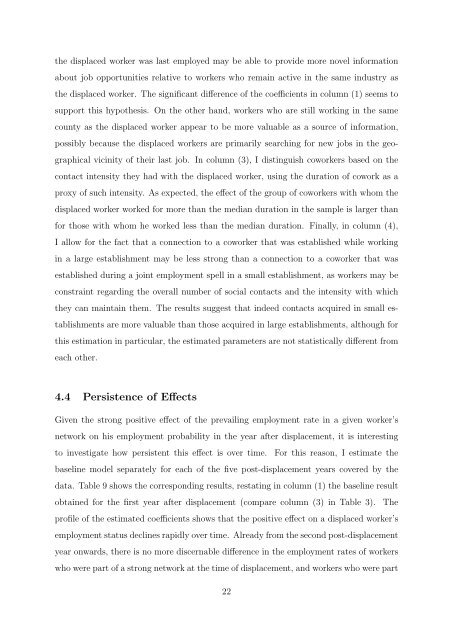paper - Universitat Pompeu Fabra
paper - Universitat Pompeu Fabra
paper - Universitat Pompeu Fabra
You also want an ePaper? Increase the reach of your titles
YUMPU automatically turns print PDFs into web optimized ePapers that Google loves.
the displaced worker was last employed may be able to provide more novel information<br />
about job opportunities relative to workers who remain active in the same industry as<br />
the displaced worker. The significant difference of the coefficients in column (1) seems to<br />
support this hypothesis. On the other hand, workers who are still working in the same<br />
county as the displaced worker appear to be more valuable as a source of information,<br />
possibly because the displaced workers are primarily searching for new jobs in the geographical<br />
vicinity of their last job. In column (3), I distinguish coworkers based on the<br />
contact intensity they had with the displaced worker, using the duration of cowork as a<br />
proxy of such intensity. As expected, the effect of the group of coworkers with whom the<br />
displaced worker worked for more than the median duration in the sample is larger than<br />
for those with whom he worked less than the median duration. Finally, in column (4),<br />
I allow for the fact that a connection to a coworker that was established while working<br />
in a large establishment may be less strong than a connection to a coworker that was<br />
established during a joint employment spell in a small establishment, as workers may be<br />
constraint regarding the overall number of social contacts and the intensity with which<br />
they can maintain them. The results suggest that indeed contacts acquired in small establishments<br />
are more valuable than those acquired in large establishments, although for<br />
this estimation in particular, the estimated parameters are not statistically different from<br />
each other.<br />
4.4 Persistence of Effects<br />
Given the strong positive effect of the prevailing employment rate in a given worker’s<br />
network on his employment probability in the year after displacement, it is interesting<br />
to investigate how persistent this effect is over time. For this reason, I estimate the<br />
baseline model separately for each of the five post-displacement years covered by the<br />
data. Table 9 shows the corresponding results, restating in column (1) the baseline result<br />
obtained for the first year after displacement (compare column (3) in Table 3). The<br />
profile of the estimated coefficients shows that the positive effect on a displaced worker’s<br />
employment status declines rapidly over time. Already from the second post-displacement<br />
year onwards, there is no more discernable difference in the employment rates of workers<br />
who were part of a strong network at the time of displacement, and workers who were part<br />
22
















